|
WHITE
HOUSE COOK BOOK.
*
* *
CARVING.
CARVING is one
important acquisition in the routine of daily living, and all should
try to
attain a knowledge or ability to do it well, and withal gracefully.
When carving use
a chair slightly higher than the ordinary size, as it gives a better
purchase
on the meat, and appears more graceful than when standing, as is often
quite
necessary when carving a turkey, or a very large joint. More depends on
skill
than strength. The platter should be placed opposite, and sufficiently
near to
give perfect command of the article to be carved, the knife of medium
size,
sharp with a keen edge. Commence by cutting the slices thin, laying
them
carefully to one side of the platter, then afterwards placing the
desired
amount on each guest's plate, to be served in turn by the servant.
In carving fish,
care should be taken to help it in perfect flakes; for if these are
broken the
beauty of the fish is lost. The carver should acquaint himself with the
choicest parts and morsels; and to give each guest an equal share of
those
tidbits should be his maxim. Steel knives and forks should on no
account be
used in helping fish, as these are liable to impart a very disagreeable
flavor.
A fish-trowel of silver or plated silver is the proper article to use.
Gravies should
be sent to the table very hot, and in helping one to gravy or melted
butter,
place it on a vacant side of the plate, not pour it over their meat,
fish or
fowl, that they may use only as much as they like.
When serving
fowls, or meats, accompanied with stuffing, the guests should be asked
if they
would have a portion, as it is not every one to whom the flavor of
stuffing is
agreeable; in filling their plates, avoid heaping one thing upon
another, as it
makes a bad appearance.
A word about the
care of carving knives: a fine steel knife should not come in contact
with
intense heat, because it destroys its temper, and therefore impairs its
cutting
qualities. Table carving knives should not be used in the kitchen,
either
around the stove, or for cutting bread, meats, vegetables, etc.; a fine
whetstone should be kept for sharpening, and the knife cleaned
carefully to
avoid dulling its edge, all of which is quite essential to successful
carving. BEEF
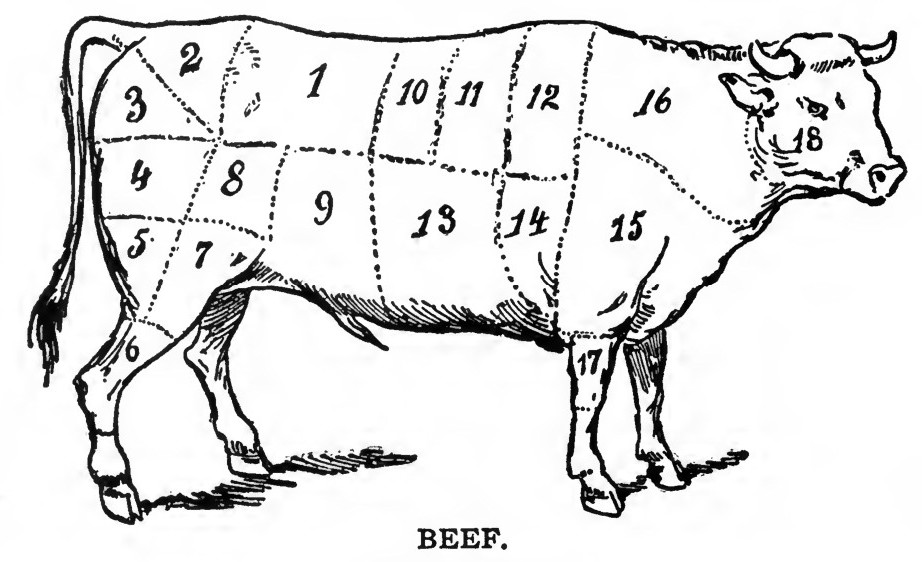
HIND-QUARTER.
No.
1. Used for choice roasts, the porter-house and sirloin steaks.
No.
2. Rump, used for steaks, stews and corned beef.
No.
3. Aitch-bone, used for boiling-pieces, stews and pot roasts.
No.
4. Buttock or round, used for steaks, pot roasts, beef à la
mode; also a
prime boiling-piece.
No.
5. Mouse-round, used for boiling and stewing.
No.
6. Shin or leg, used for soups, hashes, etc.
No.
7. Thick flank, cut with under fat, is a prime boiling-piece, good for
stews
and corned beef, pressed beef.
No.
8. Veiny piece, used for corned beef, dried beef.
No.
9. Thin flank, used for corned beef and boiling-pieces.
FORE-QUARTER.
No.
10. Five ribs called the fore-rib. This is considered the primest piece
for
roasting; also makes the finest steaks.
No.
11. Four ribs, called the middle ribs, used for roasting.
No.
12. Chuck ribs, used for second quality of roasts and steaks.
No.
13. Brisket, used for corned beef, stews, soups and spiced beef.
No.
14. Shoulder-piece, used for stews, soups, pot-roasts, mince-meat and
hashes.
Nos.
15, 16. Neck, clod or sticking-piece used for stocks, gravies, soups,
mince-pie
meat, hashes, bologna sausages, etc.
No.
17. Shin or shank, used mostly for soups and stewing.
No.
18. Cheek.
The following is
a classification of the qualities of meat, according to the several
joints of
beef, when cut up.
First Class. — Includes the sirloin with
the kidney suet (1), the rump steak piece (2), the fore-rib (11).
Second Class. — The buttock or round (4)
, the thick flank (7), the middle ribs (11).
Third Class. — The aitch-bone (3), the
mouse-round (5), the thin flank (8, 9), the chuck (12), the
shoulder-piece
(14), the brisket (13).
Fourth Class. — The clod, neck and
sticking-piece (15, 16).
Fifth Class. — Shin or shank (17).
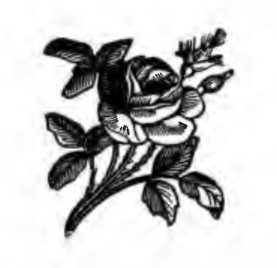
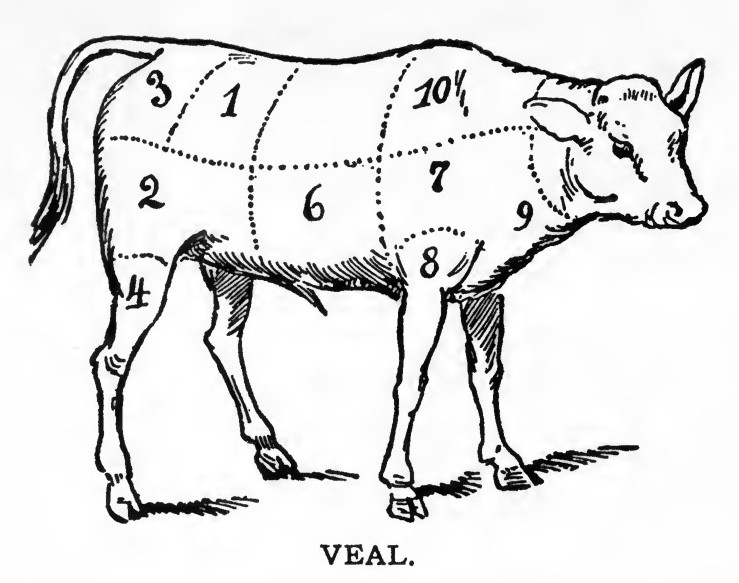
VEAL. HIND-QUARTER.
No.
1. Loin, the choicest cuts used for roasts and chops.
No.
2. Fillet, used for roasts and cutlets.
No.
3. Loin, chump-end used for roasts and chops.
No.
4. The hind-knuckle or hock, used for stews, pot-pies, meat-pies.
FORE-QUARTER.
No.
5. Neck, best end used for roasts, stews and chops.
No.
6. Breast, best end used for roasting, stews and chops.
No.
7. Blade-bone, used for pot-roasts and baked dishes.
No.
8. Fore-knuckle, used for soups and stews.
No.
9. Breast, brisket-end used for baking, stews and pot-pies.
No.
10. Neck, scrag-end used for stews, broth, meat-pies, etc.
In cutting up
veal, generally, the hind-quarter is divided into loin and leg, and the
fore-quarter into breast, neck and shoulder.
The Several
Parts of a Moderately-sized, Well-fed Calf, about eight weeks old, are nearly
of the
following weights: Loin and chump, 18 lbs.; fillet, 12 1/2 lbs.;
hind-knuckle,
5 1/2 lbs.; shoulder, 11 lbs.; neck, 11 lbs.; breast, 9 lbs., and
fore-knuckle,
5 lbs.; making a total of 144 lbs. weight.
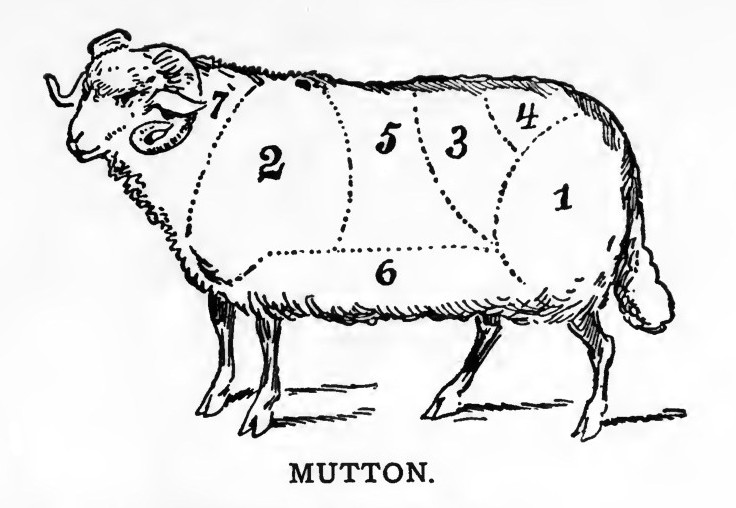
No.
1. Leg, used for roasts and for boiling.
No.
2. Shoulder, used for baked dishes and roasts.
No.
3. Loin, best end used for roasts, chops.
No.
4. Loin, chump-end used for roasts and chops.
No.
5. Back, or rib chops, used for French chops, rib chops, either
for
frying or broiling; also used for choice stews.
No.
6. Breast, used for roast, baked dishes, stews, chops.
No.
7. Neck or scrag-end, used for cutlets, stews and meat-pies.
NOTE. — A saddle
of muton or double loin is two loins cut off before the carcass is
split open
down the back. French chops are a small rib chop, the end of the bone
trimmed
off and the meat and fat cut away from the thin end, leaving the round
piece of
meat attached to the larger end, which leaves the small rib-bone bare.
Very
tender and sweet.
Mutton is prime
when cut from a carcass which has been fed out of doors, and allowed to
run
upon the hillside; they are best when about three years old. The fat
will then
be abundant, white and hard, the flesh juicy and firm, and of a clear
red
color.
For mutton
roasts, choose the shoulder, the saddle, or the loin or haunch. The leg
should
be boiled. Almost any part will do for broth.
Lamb born in the
middle of the winter, reared under shelter, and fed in a great measure
upon
milk, then killed in the spring, is considered a great delicacy, though
lamb is
good at a year old. Like all young animals, lamb ought to be thoroughly
cooked,
or it is most unwholesome.
PORK 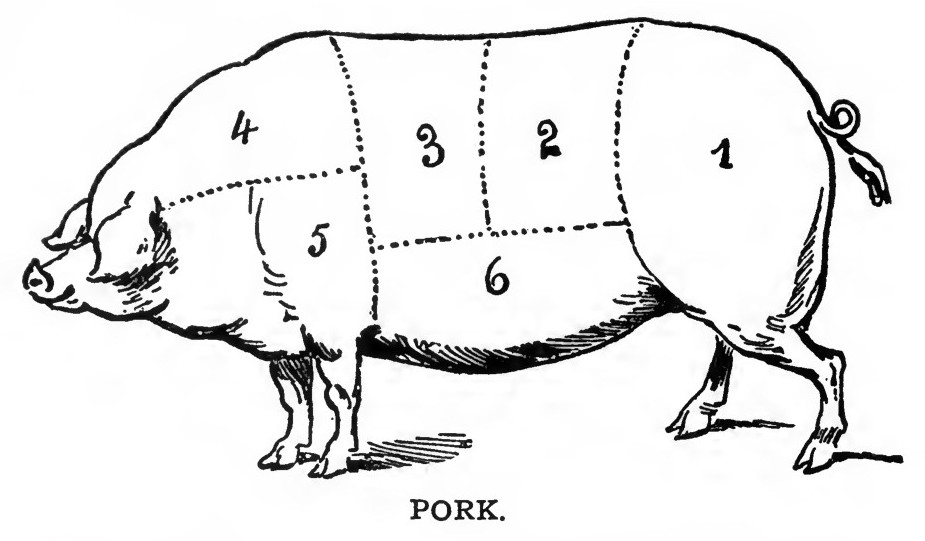
No.
1. Leg, used for smoked hams, roasts and corned pork.
No.
2. Hind-loin, used for roasts, chops and baked dishes.
No.
3. Fore-loin or ribs, used for roasts, baked dishes or chops.
No.
4. Spare-rib, used for roasts, chops, stews.
No.
5. Shoulder, used for smoked shoulder, roasts and corned pork.
No.
6. Brisket and flank, used for pickling in salt and smoked bacon.
The cheek is
used for pickling in salt, also the shank or shin. The feet are usually
used
for souse and jelly.
For family use
the leg is the most economical, that is when fresh, and the loin the
richest.
The best pork is from carcasses weighing from fifty to about one
hundred and
twenty-five pounds. Pork is a, white and close meat, and it is almost
impossible to over-roast or cook it too much; when underdone it is
exceedingly
unwholesome.
VENISON 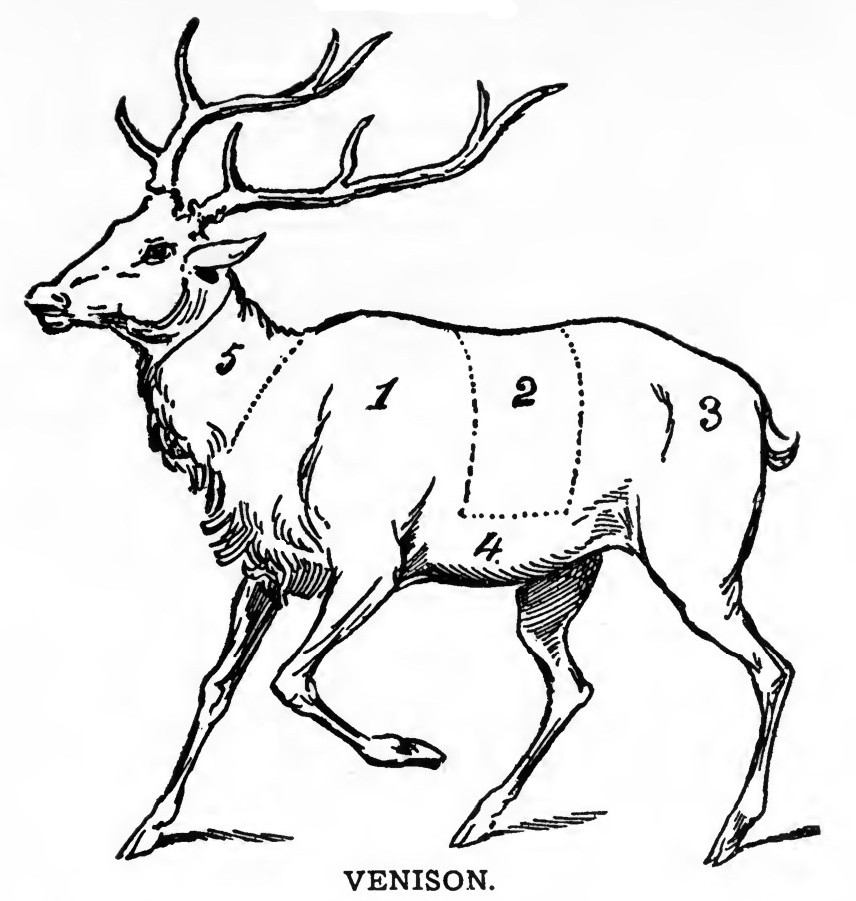
No.
1. Shoulder, used for roasting; it may be boned and stuffed, then afterwards
baked or roasted.
No.
2. Fore-loin, used for roasts and steaks.
No.
3. Haunch or loin, used for roasts, steaks, stews. The ribs cut close
may be
used for soups. Good for pickling and making into smoked venison.
No.
4. Breast, used for baking dishes, stewing.
No.
5. Scrag or neck, used for soups.
The choice of
venison should be judged by the fat, which, when the venison is young,
should
be thick, clear and close, and the meat a very dark red, The flesh of a
female
deer about four years old, is the sweetest and best of venison.
Buck venison,
which is in season from June to the end of September, is finer than doe
venison, which is in season from October to December. Neither should be
dressed
at any other time of year, and no meat requires so much care as venison
in
killing, preserving and dressing.
SIRLOIN OF BEEF 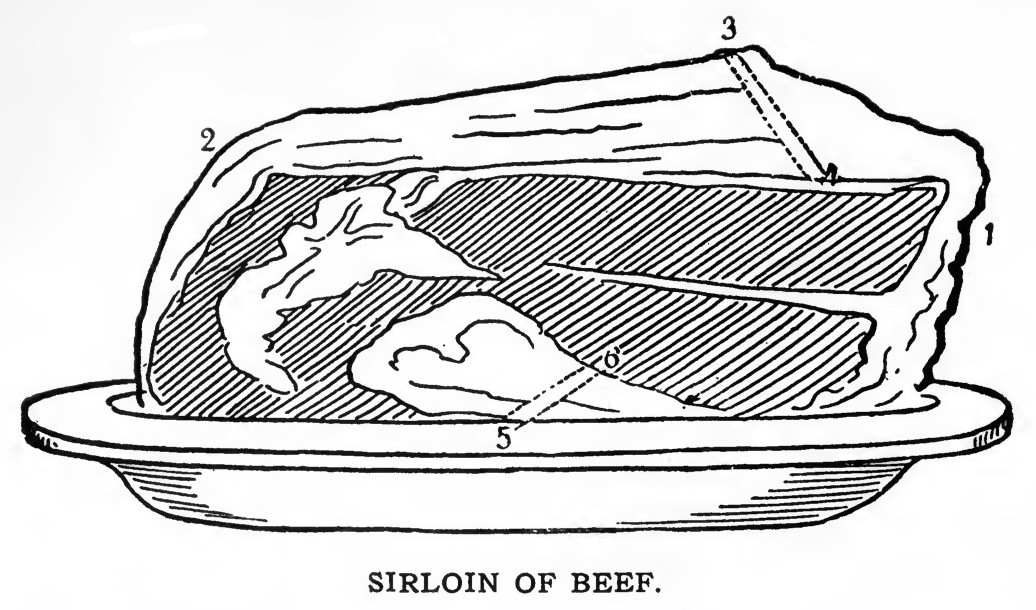
THIS choice
roasting-piece should be cut with one good firm stroke from end to end
of the
joint, at the upper part, in thin, long, even slices in the direction
of the
line from 1 to 2, cutting across the grain, serving each guest with
some of the
fat with the lean; this may be done by cutting a small, thin slice from
underneath the bone from 5 to 6, through the tenderloin.
Another way of
carving this piece, and which will be of great assistance in doing it
well, is
to insert the knife just above the bone at the bottom, and run sharply
along,
dividing the meat from the bone at the bottom and end, thus leaving it
perfectly flat; then carve in long, thin slices the usual way. When the
bone
has been removed and the sirloin rolled before it is cooked, it is laid
upon
the platter on one end, and an even, thin slice is carved across the
grain of
the upper surface.
Roast ribs
should be carved in thin, even slices from the thick end towards the
thin in
the same manner as the sirloin; this can be more easily and cleanly
done if the
carving knife is first run along between the meat and the end and
rib-bones,
thus leaving it free from bone to be cut into slices.
Tongue. — To carve this it should
be cut crosswise, the middle being the best; cut in very thin slices,
thereby
improving its delicacy, making it more tempting; as is the case of all
well-carved meats. The root of the tongue is usually left on the
platter.
BREAST OF VEAL 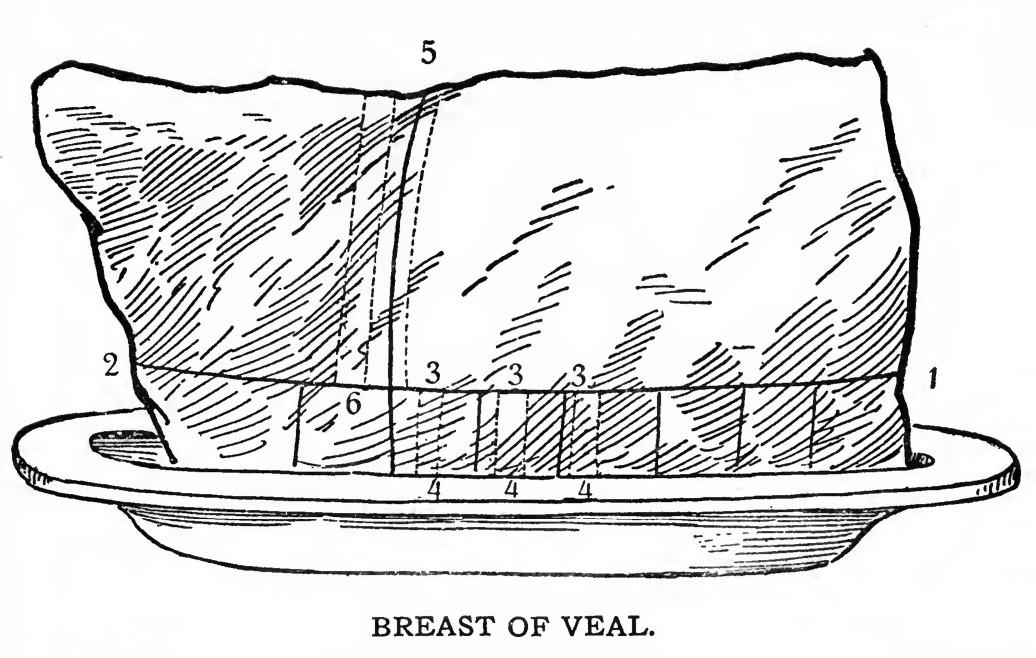
THIS piece is
quite similar to a fore-quarter of lamb after the shoulder has been
taken off.
A breast of veal consists of two parts, the rib-bones and the gristly
brisket.
These parts may be separated by sharply passing the carving knife in
the
direction of the line from 1 to 2; and when they are entirely divided,
the
rib-bones should be carved in the direction of the line from 5 to 6,
and the
brisket can be helped by cutting slices from 3 to 4.
The carver
should ask the guests whether they have a preference for the brisket or
ribs;
and if there be a sweetbread served with the dish, as is frequently
with this
roast of veal, each person should receive a piece.
Though veal and
lamb contain less nutrition than beef and mutton, in proportion to
their
weight, they are often preferred to these latter meats on account of
their
delicacy of texture and flavor. A whole breast of veal weighs from nine
to
twelve pounds.
FILLET OF VEAL 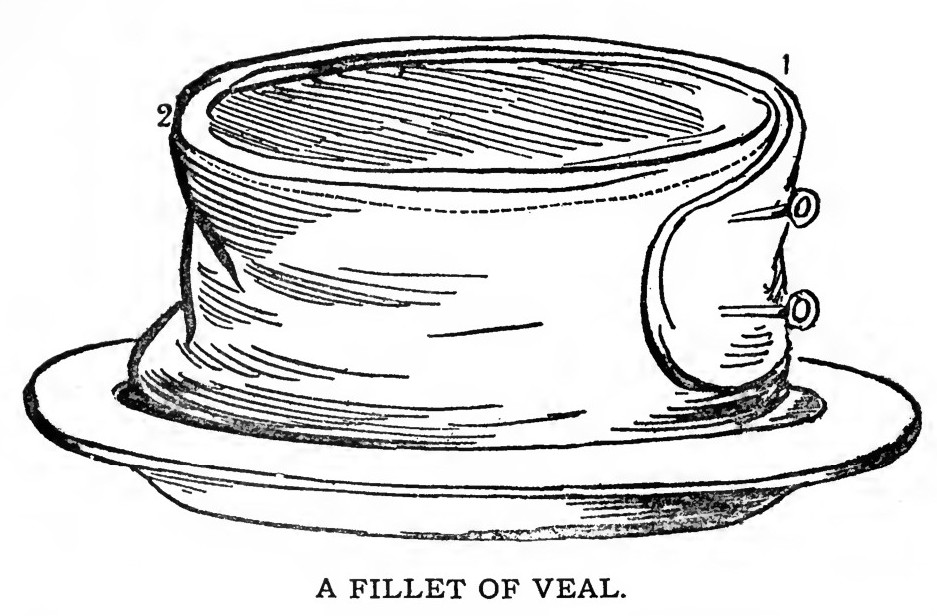
A FILLET of veal
is one of the prime roasts of veal; it is taken from the leg above the
knuckle;
a piece weighing from ten to twelve pounds is a good size and requires
about
four hours for roasting. Before roasting, it is dressed with a force
meat or
stuffing placed in the cavity from where the bone was taken out and the
flap
tightly secured together with skewers; many bind it together with tape.
To carve it, cut
in even thin slices off from the whole of the upper part or top, in the
same
manner as from a rolled roast of beef, as in the direction of the figs.
1 and
2; this gives the person served some of the dressing with each slice of
meat.
Veal is very
unwholesome unless it is cooked thoroughly, and when roasted should be
of a
rich brown color. Bacon, fried pork, sausage balls, with greens, are
among the
accompaniments of roasted veal, also a cut lemon.
NECK OF VEAL
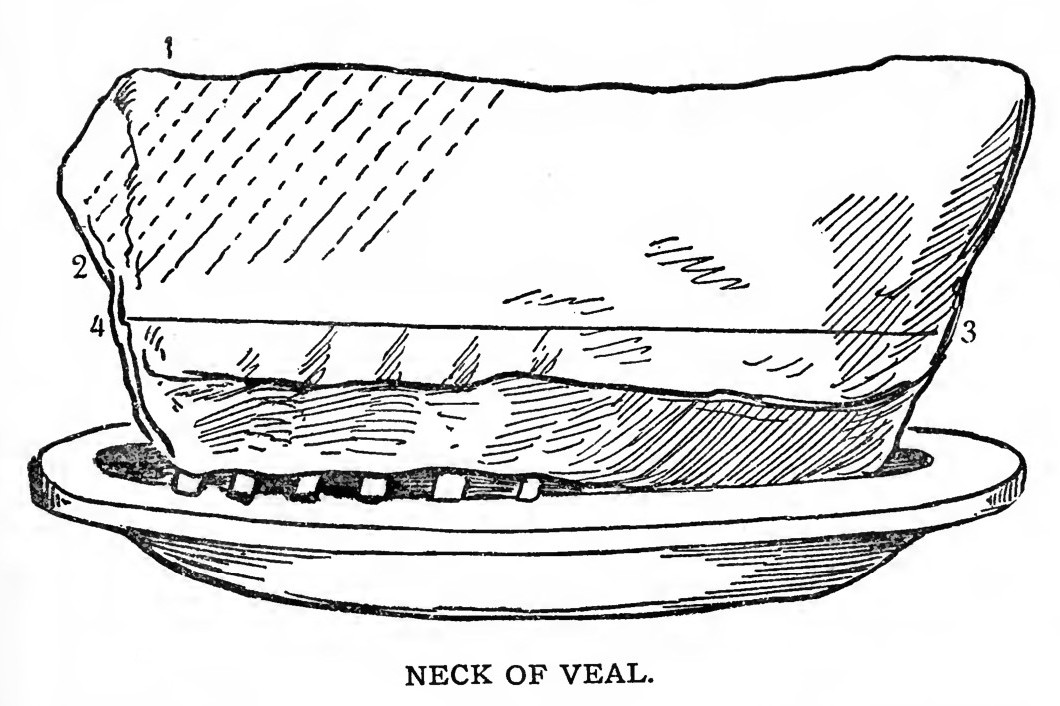
THE best end of
a neck of veal makes a very good roasting-piece; it, however, is
composed of
bone and ribs that make it quite difficult to carve, unless it is done
properly. To attempt to carve each chop and serve it, you would not
only place
too large a piece upon the plate of the person you intend to serve, but
you
would waste much time, and should the vertebras have not been removed
by the
butcher, you would be compelled to exercise such a degree of strength
that
would make one's appearance very ungraceful, and possibly, too,
throwing gravy
over your neighbor sitting next to you. The correct way to carve this
roast is to
cut diagonally from fig. 1 to 2, and help in slices of moderate
thickness; then
it may be cut from 3 to 4, in order to separate the small bones; divide
and
serve them, having first inquired if they are desired.
This joint is
usually sent to the table accompanied by bacon, ham, tongue, or pickled
pork,
on a separate dish and with a cut lemon on a plate. There are also a
number of
sauces that are suitable with this roast.
LEG OF MUTTON
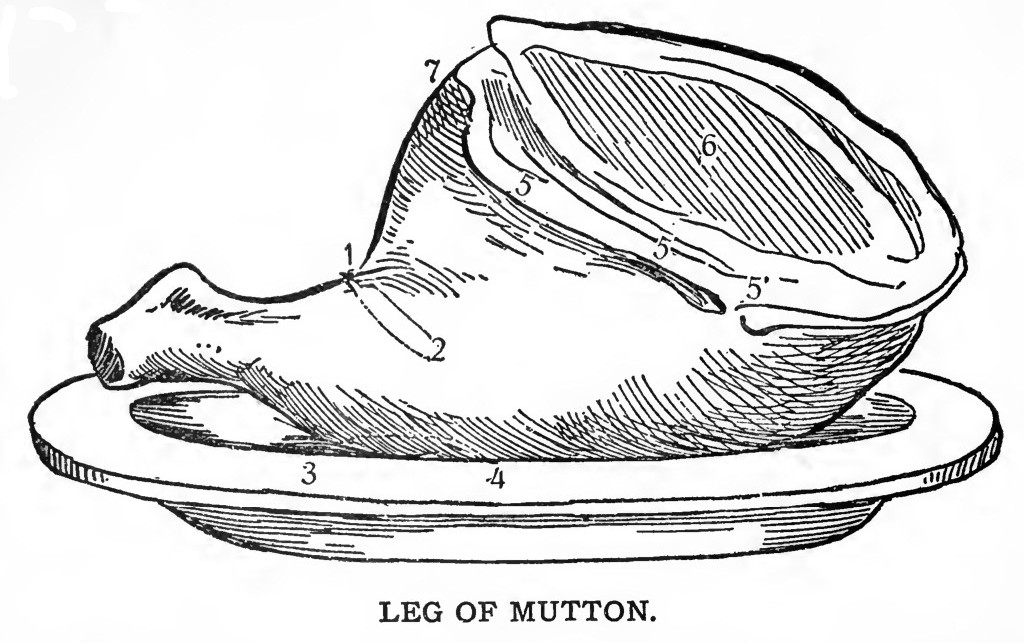
THE best mutton,
and that from which most nourishment is obtained is that of sheep from
three to
six years old, and which have been fed on dry, sweet pastures; then
mutton is
in its prime, the flesh being firm, juicy, dark colored and full of the
richest
gravy. When mutton is two years old, the meat is flabby, pale and
savorless.
In carving a
roasted leg, the best slices are found by cutting quite down to the
bone, in
the direction from 1 to 2, and slices may be taken from either side.
Some very good
cuts are taken from the broad end from 5 to 6, and the fat on this
ridge is
very much liked by many. The cramp-bone is a delicacy, and is obtained
by
cutting down to the bone at 4, and running the knife under it in a
semicircular
direction to 3. The nearer the knuckle the drier the meat, but the
under side
contains the most finely grained meat, from which slices may be cut
lengthwise.
When sent to the table a frill of paper around the knuckle will improve
its
appearance.
FOREQUARTER OF LAMB 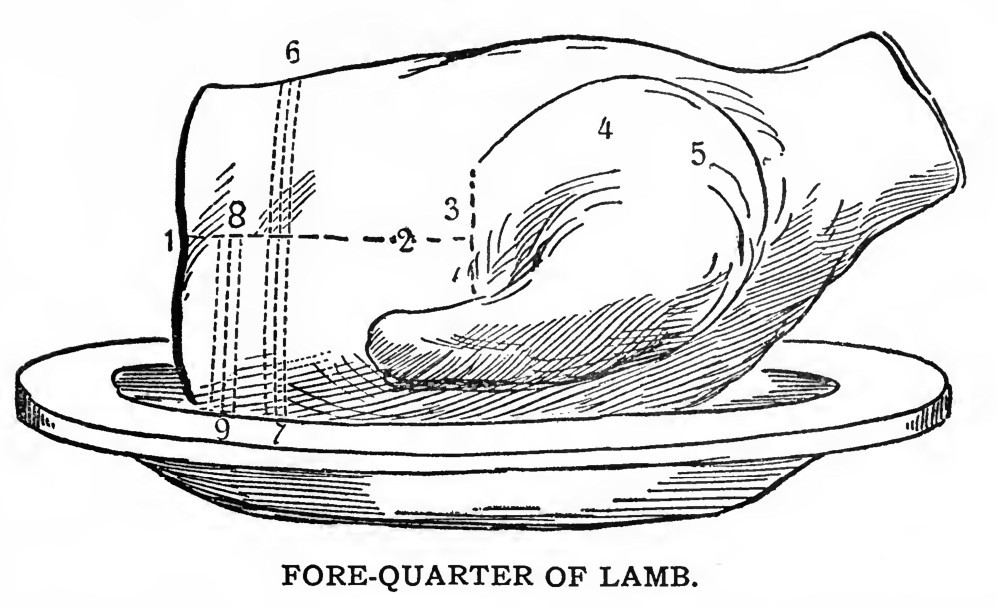
THE first cut to
be made in carving a fore-quarter of lamb is to separate the shoulder
from the breast
and ribs; this is done by passing a sharp carving knife lightly around
the
dotted line as shown by the figs. 3, 4 and 5, so as to cut through the
skin,
and then, by raising with a little force the shoulder, into which the
fork
should be firmly fixed, it will easily separate with just a little more
cutting
with the knife; care should be taken not to cut away too much of the
meat from
the breast when dividing the shoulder from it, as that would mar its
appearance. The shoulder may be placed upon a separate dish for
convenience.
The next process is to divide the ribs from the brisket by cutting
through the
meat in the line from 1 to 2; then the ribs may be carved in the
direct-ion of
the line 6 to 7, and the brisket from 8 to 9. The carver should always
ascertain
whether the guest prefers ribs, brisket, or a piece of the shoulder.
HAM 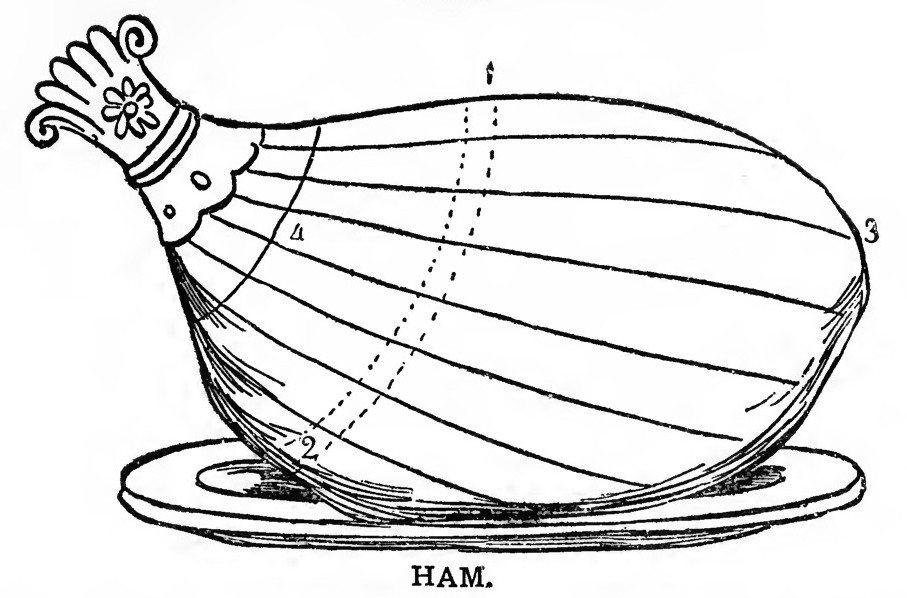
THE carver in
cutting a ham must be guided according as he desires to practice
economy, or
have at once fine slices out of the prime part. Under the first
supposition, he
will commence at the knuckle end, and cut off thin slices toward the
thick and
upper part of the ham.
To reach the
choicer portion of the ham, the knife, which must be very sharp and
thin,
should be carried quite down to the bone through the thick fat in the
direction
of the line from 1 to 2, The slices should be even and thin, cutting
both lean
and fat together, always cutting down to the bone. Some cut a circular
hole in
the middle of a ham gradually enlarging it outwardly. Then again many
carve a ham
by first cutting from 1 to 2, then across the other way from 3 to 4.
Remove the
skin after the ham is cooked and send to the table with dots of dry
pepper or
dry mustard on the top, a tuft of fringed paper twisted about the
knuckle, and
plenty of fresh parsley around the dish. This will always insure an
inviting
appearance.
Roast Pig. — The modern way of
serving a pig is not to send it to the table whole, but have it carved
partially by the cook; first, by dividing the shoulder from the body;
then the
leg in the same manner, also separating the ribs into convenient
portions. The
head may be divided and placed on the same platter. To be served as hot
as
possible.
A Spare Rib of
Pork is carved by cutting slices from the fleshy part, after which the
bones should
be disjointed and separated. A leg of pork may be carved in the same
manner as
a ham.
HAUNCH OF VENISON
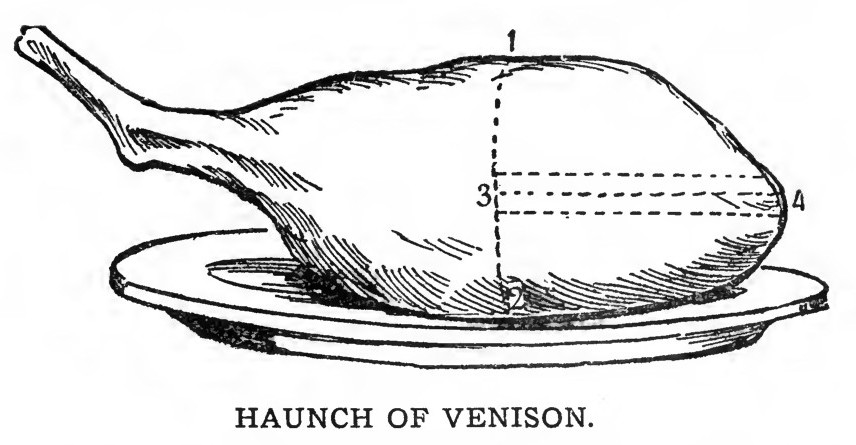
A HAUNCH of
venison is the prime joint, and is carved very similar to almost any
roasted or
boiled leg; it should be first cut crosswise down to the bone following
the
line from 1 to 2; then turn the platter with the knuckle farthest from
you, put
in the point of the knife, and cut down as far as you can, in the
directions
shown by the dotted lines from 3 to 4; then there can be taken out as
many
slices as is required on the right and left of this. Slices of venison
should
be cut thin, and gravy given with them, but as there is a special sauce
made
with red wine and currant jelly to accompany this meat, do not serve
gravy
before asking the guest if he pleases to have any.
The fat of this
meat is like mutton, apt to cool soon, and become hard and disagreeable
to the
palate; it should, therefore, be served always on warm plates, and the
platter
kept over a hot-water dish, or spirit lamp. Many cooks dish it up with
a white
paper frill pinned around the knuckle bone.
A haunch of
mutton is carved the same as a haunch of venison.
TURKEY
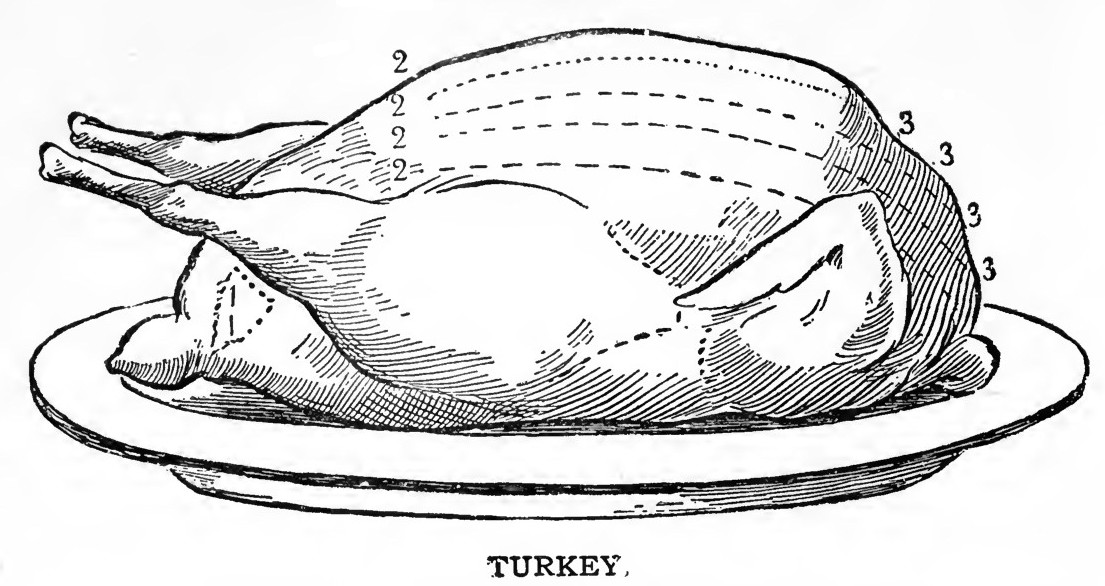
A TURKEY having
been relieved from strings and skewers used in trussing should be
placed on the
table with the head or neck at the carver's right hand. An expert
carver places
the fork in the turkey, and does not remove it until the whole is
divided.
First insert the fork firmly in the lower part of the breast, just
forward of
fig. 2, then sever the legs and wings on both sides, if the whole is to
be
carved, cutting neatly through the joint next to the body, letting
these parts
lie on the platter. Next, cut downward from the breast from 2 to 3 as
many even
slices of the white meat as may be desired, placing the pieces neatly
on one
side of the platter. Now un joint the legs and wings at the middle
joint, which
can be done very skillfully by a little practice. Make an opening into
the
cavity of the turkey for dipping out the inside dressing, by cutting a
piece
from the rear part 1, 1, called the apron. Consult the tastes of the
guests as
to which part is preferred; if no choice is expressed, serve a portion
of both
light and dark meat. One of the most delicate parts of the turkey are
two
little muscles, lying in small dish-like cavities on each side of the
back, a
little behind the leg attachments; the next most delicate meat fills
the
cavities in the neck bone, and next to this, that on the second joints.
The
lower part of the leg (or drumstick, as it is called) being hard, tough
and
stringy, is rarely ever helped to any one, but allowed to remain on the
dish.
ROAST GOOSE 
TO CARVE a
goose, first begin by separating the leg from the body, by putting the
fork
into the small end of the limb, pressing it closely to the body, then
passing the
knife under at 2, and turning the leg back as you cut through the
joint. To
take off the wing, insert the fork in the small end of the pinion, and
press it
close to the body; put the knife in at fig. 1, and divide the joint.
When the
legs and wings are off, the breast may be carved in long, even slices,
as
represented in the lines from 1 to 2. The back and lower side bones, as
well as
the two lower side bones by the wing, may be cut off; but the best
pieces of
the goose are the breast and thighs, after being separated from the
drumsticks.
Serve a little .of the dressing from the inside, by making a circular
slice in
the apron at fig. 3. A goose should never be over a year old; a tough
goose is
very difficult to carve, and certainly most difficult to eat.
FOWLS.
FIRST insert the
knife between the leg and the body, and cut to the bone; then turn the
leg back
with the fork, and if the fowl is tender the joint will give away
easily. The
wing is broken off the same way, only dividing the joint with the
knife, in the
direction from 1 to 2, The four quarters having been removed in this
way, take
off the merry-thought and the neck-bones; these last are to be removed
by
putting the knife in at figs. 3 and 4, pressing it hard, when they will
break
off from the part that sticks to the breast To separate the breast from
the
body of the fowl, cut through the tender ribs close to the breast,
quite down
to the tail. Now turn the fowl over, back upwards; put the knife into
the bone
midway between the neck and the rump, and on raising the lower end it
will
separate readily. Turn now the rump from you, and take off very neatly
the two
side bones, and the fowl is carved. In separating the thigh from the
drumstick,
the knife must be inserted exactly at the joint, for if not accurately
hit,
some difficulty will be experienced to get them apart; this is easily
acquired
by practice. There is no difference in carving roast and boiled fowls
if full
grown; but in very young fowls the breast is usually served whole; the
wings
and breast are considered the best parts, but in young ones the legs
are the
most juicy. In the case of a capon or large fowl, slices may be cut off
at the
breast, the same as carving a pheasant.
ROAST DUCK 
A YOUNG duckling
may be carved in the same manner as a fowl, the legs and wings being
taken oft
first on either side. When the duck is full size, carve it like a
goose; first
cutting it in slices from the breast, beginning close to the wing and
proceeding upward towards the breast bone, as is represented by the
lines 1 to
2. An opening may be made by cutting out a circular slice, as shown by
the
dotted lines at number 3.
Some are fond of
the feet, and when dressing the duck, these should be neatly skinned
and never
removed. Wild duck is highly esteemed by epicures; it is trussed like a
tame
duck, and carved in the same manner, the breast being the choicest part.
PARTRIDGES.
PARTRIDGES are
generally cleaned and trussed the same way as a pheasant, but the
custom of
cooking them with the heads on is going into disuse somewhat. The usual
way of
carving them is similar to a pigeon, dividing it into two equal parts.
Another
method is to cut it into three pieces, by severing a wing and leg on
either
side from the body, by following the lines 1 to 2, thus making two
servings of
those parts, leaving the breast for a third plate. The third method is
to
thrust back the body from the legs, and cut through the middle of the
breast,
thus making four portions that may be served. Grouse and
prairie-chicken are
carved from the breast when they are large, and quartered or halved
when of
medium size.
PHEASANT 
PLACE your fork
firmly in the centre of the breast of this large game bird and cut deep
slices
to the bone at figs. 1 and 2; then take off the leg in the line from 3
and 4,
and the wing 3 and 5, severing both sides the same. In taking off the
wings, be
careful not to cut too near the neck; if you do you will hit upon the
neck-bone, from which the wing must be separated. Pass the knife
through the
line 6, and under the merry-thought towards the neck, which will detach
it. Cut
the other parts as in a fowl. The breast, wings and merry-thought of a
pheasant
are the most highly prized, although the legs are considered very
finely
flavored. Pheasants are frequently roasted with the head left on; in
that case,
when dressing them, bring the head round under the wing, and fix it on
the
point of a skewer.
PIGEONS.
A VERY good way
of carving these birds is to insert the knife at fig. 1, and cut both
ways to 2
and 3, when each portion may be divided into two pieces, then served.
Pigeons,
if not too large, may be cut in halves, either across or down the
middle,
cutting them into two equal parts; if young and small they may be
served
entirely whole.
Tame pigeons
should be cooked as soon as possible after they are killed, as they
very
quickly lose their flavor. Wild pigeons, on the contrary, should hang a
day or
two in a cool place before they are dressed. Oranges cut into halves
are used
as a garnish for dishes of small birds, such as pigeons, quail,
woodcock,
squabs, snipe, etc. These small birds are either served whole or split
down the
back, making two servings.
MACKEREL 
THE mackerel is
one of the most beautiful of fish, being known by its silvery
whiteness. It
sometimes attains to the length of twenty inches, but usually, when
fully
grown, is about fourteen or sixteen inches long, and about two pounds
in
weight. To carve a baked mackerel, first remove the head and tail by
cutting
downward at 1 and 2; then split them down the back, so as to serve each
person
a part of each side piece. The roe should be divided in small pieces
and served
with each piece of fish. Other whole fish may be carved in the same
manner. The
fish is laid upon a little sauce or folded napkin, on a hot dish, and
garnished
with parsley.
BOILED
SALMON.
THIS fish is
seldom sent to the table whole, being too large for any ordinary sized
family;
the middle cut is considered the choicest to boil. To carve it, first
run the
knife down and along the upper side of the fish from 1 to 2, then again
on the
lower side from 3 to 4. Serve the thick part, cutting it lengthwise in
slices
in the direction of the line from 1 to 2, and the thin part
breadthwise, or in
the direction from 5 to 6. A slice of the thick with one of the thin,
where
lies the fat, should be served to each guest. Care should be taken when
carving
not to break the flakes of the fish, as that impairs its appearance.
The flesh
of the salmon is rich and delicious in flavor. Salmon is in season from
the
first of February to the end of August.
|

